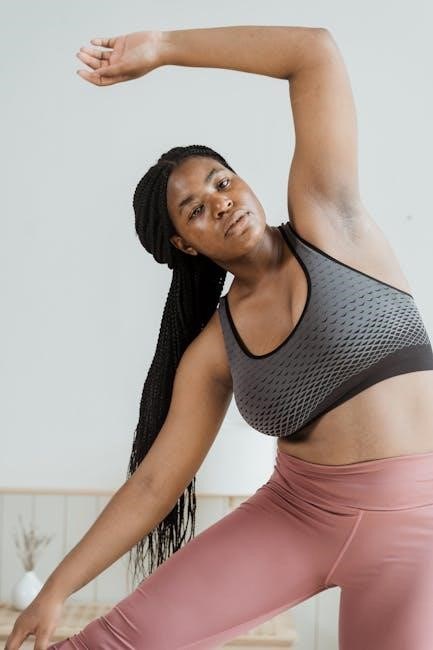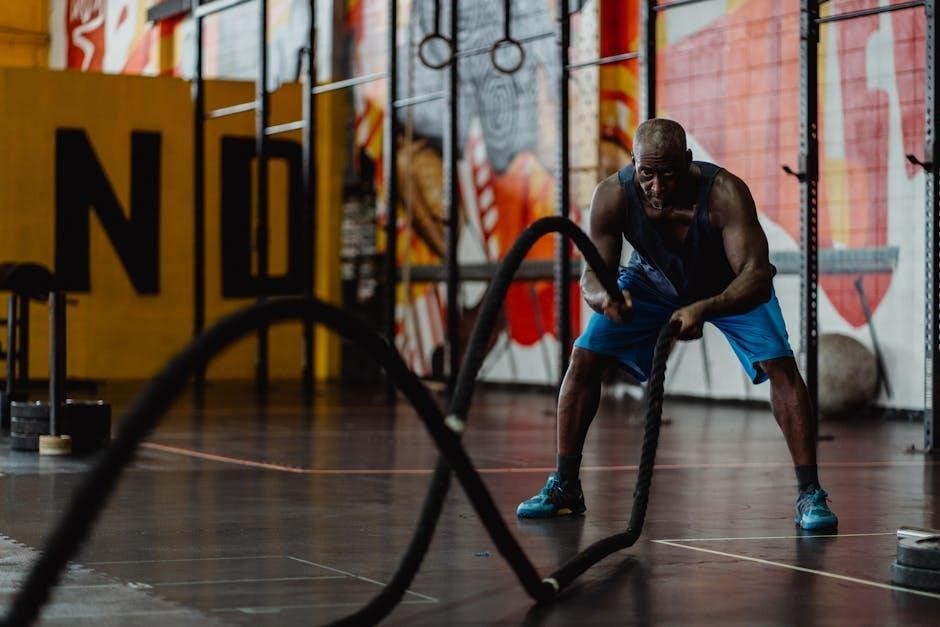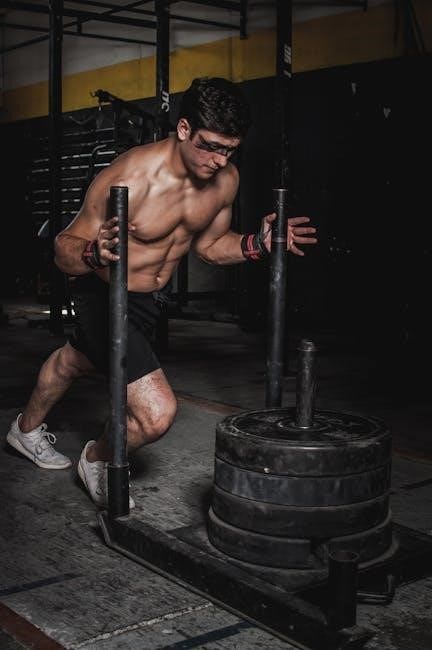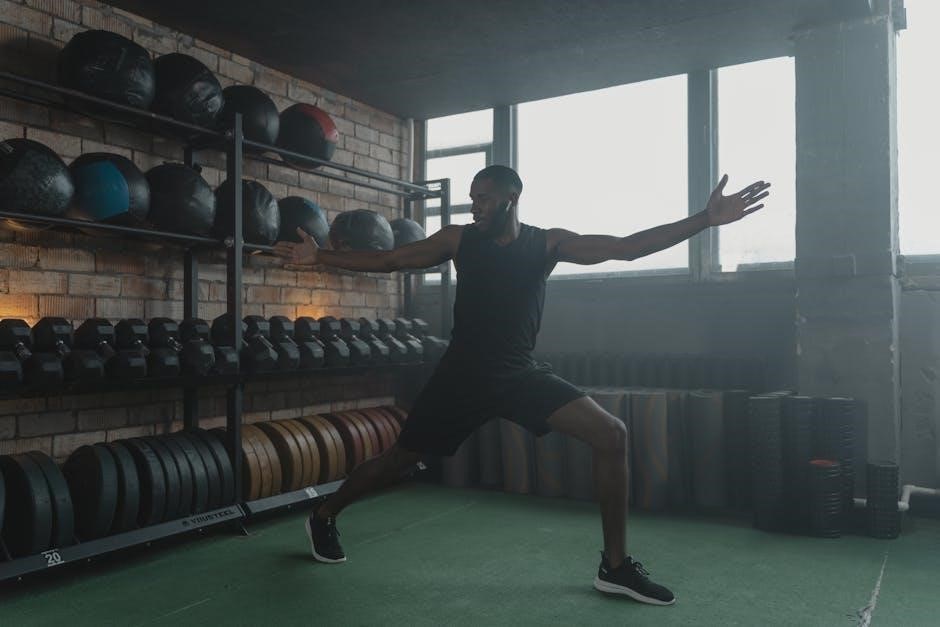CrossFit movements form the foundation of functional fitness‚ emphasizing versatility and efficiency. Mastering these exercises enhances strength‚ mobility‚ and overall athleticism‚ with resources like PDF lists and video libraries available to guide mastery.
1.1. What Are CrossFit Movements?
CrossFit movements are essential functional exercises designed to improve strength‚ mobility‚ and overall athleticism. They include squats‚ deadlifts‚ presses‚ and bodyweight movements like pull-ups and push-ups. These exercises mimic real-life actions‚ focusing on efficiency and versatility. Foundational movements like the squat‚ press‚ and deadlift are cornerstones of CrossFit training‚ often scaled to suit individual fitness levels. Resources such as PDF lists and video libraries provide detailed guides‚ helping athletes master proper form and technique for optimal performance and safety in their workouts.
1.2. Importance of Mastering CrossFit Movements
Mastering CrossFit movements is crucial for building a solid fitness foundation. Proper technique ensures safety‚ prevents injuries‚ and maximizes efficiency. Consistent execution of movements like squats‚ presses‚ and deadlifts enhances strength‚ coordination‚ and overall athleticism. Proficiency also allows for better progression in workouts‚ enabling athletes to perform more advanced exercises effectively. Additionally‚ mastery boosts confidence and performance in benchmark WODs‚ making it essential for achieving long-term fitness goals. Resources like PDF guides and video tutorials provide detailed instruction to help athletes refine their skills.
1.3. Benefits of Learning CrossFit Movements
Learning CrossFit movements offers numerous benefits‚ including improved strength‚ endurance‚ and flexibility. These exercises enhance functional fitness‚ preparing the body for real-life tasks. Proper movement execution boosts coordination and balance‚ reducing injury risk. CrossFit movements also promote mental discipline and confidence. A PDF guide provides a structured list of movements‚ helping athletes track progress and stay organized. Regular practice leads to overall physical and mental well-being‚ making it a holistic approach to fitness. Mastery of these movements fosters a strong foundation for advanced training.
Foundational CrossFit Movements
Mastering foundational CrossFit movements builds a strong fitness base. These include squats‚ presses‚ deadlifts‚ and weightlifting techniques. A PDF list provides clear guidance for athletes.
2.1. The 9 Foundational Movements
The 9 foundational CrossFit movements are essential for building strength‚ mobility‚ and coordination. These movements include the air squat‚ front squat‚ overhead squat‚ press‚ push press‚ push jerk‚ deadlift‚ sumo deadlift high pull‚ and med ball clean. Each movement targets different muscle groups and functional skills. A PDF list of these movements is a valuable resource for tracking progress and understanding proper form. Mastering these basics ensures a solid foundation for more advanced techniques and overall fitness development.
2.2. Squat‚ Front Squat‚ and Overhead Squat
The squat‚ front squat‚ and overhead squat are fundamental movements in CrossFit‚ focusing on lower body strength and mobility. The air squat is a bodyweight movement that improves flexibility and coordination. The front squat involves holding a barbell at shoulder height‚ enhancing upper back strength and core stability. The overhead squat requires a full range of motion with the barbell overhead‚ challenging mobility and control. Proper form is crucial for safety and effectiveness. A PDF guide can provide visual cues and progressions for mastering these squats.
2.3. Press‚ Push Press‚ and Push Jerk
The press‚ push press‚ and push jerk are essential movements for building upper body strength and power. The press involves strictly pressing a barbell overhead. The push press uses a slight leg drive to assist‚ while the push jerk incorporates a deeper leg split and faster movement. These exercises improve shoulder mobility and overall pressing power. A PDF guide can provide detailed instructions and progressions for mastering these lifts safely and effectively. Proper form and progression are key to avoiding injury and maximizing results.
2.4. Deadlift and Sumo Deadlift High Pull
The deadlift and sumo deadlift high pull are cornerstone movements in CrossFit‚ focusing on raw strength and power. The deadlift involves lifting a barbell from the ground to hip level‚ engaging the entire posterior chain. The sumo deadlift high pull uses a wider stance and includes a pull‚ targeting the shoulders and enhancing explosiveness. Both movements build foundational strength and power‚ essential for CrossFit athletes. A detailed PDF guide provides step-by-step instructions and scaling options for all fitness levels.
2.5. Med Ball Clean
The Med Ball Clean is a dynamic CrossFit movement that enhances explosive power and coordination. It begins with the medicine ball on the ground‚ then involves a hip hinge to lift it‚ followed by a powerful drive to bring it to shoulder height. This movement engages the entire body‚ emphasizing the importance of proper form to maximize effectiveness and prevent injury. A detailed CrossFit movements list PDF offers step-by-step instructions and variations to suit different fitness levels‚ ensuring mastery of the Med Ball Clean effectively.

Advanced CrossFit Movements
Advanced CrossFit movements combine strength‚ skill‚ and technique‚ focusing on complex exercises like Olympic lifts and gymnastics. They emphasize progression and scaling for mastery.
3.1. Olympic Lifts in CrossFit
Olympic lifts‚ such as the clean and jerk and snatch‚ are cornerstone movements in CrossFit. They require precision‚ power‚ and coordination‚ focusing on full-body engagement. These lifts enhance strength‚ speed‚ and athleticism. Proper form is critical to avoid injury and maximize efficiency. CrossFitters often practice variations like the power clean and push jerk to build proficiency. Mastery of these lifts is a hallmark of advanced CrossFit athletes‚ as they are frequently incorporated into high-intensity workouts and competitions.
3.2. Muscle-Ups and Ring Dips
Muscle-ups and ring dips are advanced CrossFit movements that target upper body strength‚ control‚ and coordination. Muscle-ups combine a pull-up and dip‚ requiring a strong transition from the pulling phase to the dipping phase. Ring dips focus on tricep and shoulder strength‚ often serving as a progression toward muscle-ups. Both movements build functional upper body power and are integral to advanced CrossFit workouts‚ emphasizing mastery of bodyweight and ring dynamics for overall fitness and performance.
3.3. Rope Climbs and Pull-Ups
Rope climbs and pull-ups are essential CrossFit movements that build upper body strength and endurance. Rope climbs target grip strength‚ core stability‚ and cardiovascular fitness‚ while pull-ups focus on lat activation and overall pulling power. Both movements are foundational for building functional fitness and are commonly incorporated into WODs to enhance full-body conditioning. Mastery of these skills improves overall athleticism and prepares athletes for more advanced exercises in CrossFit training programs.
3.4. Handstand Push-Ups and Walkovers
Handstand push-ups (HSPUs) and walkovers are advanced CrossFit movements that require inversion‚ strength‚ and control. HSPUs build shoulder strength‚ core stability‚ and overall upper body power‚ while walkovers improve mobility‚ coordination‚ and transitions between movements. These exercises are integral for developing functional fitness and are often used in competitive workouts. Mastery of HSPUs and walkovers enhances athleticism and prepares athletes for complex skills in CrossFit training‚ emphasizing the importance of progression and proper technique.
CrossFit Benchmark Workouts (WODs)
CrossFit Benchmark WODs‚ like “Fran” and “Cindy‚” are standardized workouts used to measure fitness and track progress. They represent core movements and intensity in CrossFit training.
4.1. The “Girls” Benchmark WODs
The “Girls” are a series of benchmark CrossFit workouts named after women‚ designed to test strength‚ speed‚ and endurance. Workouts like “Fran” (thrusters and pull-ups) and “Cindy” (pull-ups‚ push-ups‚ and air squats) are iconic. Each WOD has a specific time domain and movement pattern‚ allowing athletes to measure progress over time. These workouts are scalable and often used to assess fitness levels. They embody the CrossFit philosophy of variance and intensity‚ making them a cornerstone of CrossFit training and community culture worldwide.
4.2. The “Heroes” Benchmark WODs
The “Heroes” benchmark workouts are intense‚ longer-duration WODs named in honor of fallen heroes‚ such as first responders or military personnel. Examples include “Murph” (mile run‚ 100 pull-ups‚ 200 push-ups‚ 300 squats‚ mile run) and “Griff” (800m run‚ 400m swim‚ 800m run). These workouts are designed to test endurance‚ strength‚ and mental toughness. They often involve high-rep movements and are meant to challenge athletes to push beyond their limits while paying tribute to those who sacrificed their lives in service.
4.3. CrossFit Open Workouts
CrossFit Open workouts are annual events where athletes worldwide complete the same workouts‚ released weekly. These workouts test a wide range of skills‚ from basic movements to advanced techniques. Examples include pull-ups‚ thrusters‚ and burpees. Open workouts are designed to be scalable‚ making them accessible to all fitness levels. They serve as a qualification pathway for higher-level competitions and foster a sense of community. Each workout is released with demonstrations and strategies to help athletes optimize their performance and track progress over time.

Scaling CrossFit Movements
Scaling CrossFit movements ensures accessibility for all fitness levels‚ adjusting reps‚ weights‚ or ranges of motion. This approach maintains form integrity and promotes progressive overload safely.
5.1. How to Scale Workouts for Beginners
Scaling CrossFit workouts for beginners involves modifying movements to suit individual fitness levels while maintaining proper form. This can include reducing weights‚ lowering rep counts‚ or substituting complex movements with simpler alternatives; For example‚ a beginner might use a PVC pipe for snatches or perform push-ups instead of pull-ups. The goal is to build strength and technique gradually‚ ensuring safety and progress. Coaches often use scalable options to tailor WODs‚ helping newcomers adapt to the demands of CrossFit effectively.

5.2. Modifying Movements for Different Fitness Levels
Modifying CrossFit movements ensures accessibility for all athletes‚ regardless of skill or experience. Beginners may use resistance bands for pull-ups or substitute muscle-ups with assisted dips. Intermediate athletes might reduce range of motion or lower weights‚ while advanced individuals can increase intensity. Progressions‚ such as scaling squats to pistol squats‚ allow for gradual improvement. Coaches often adjust reps‚ time‚ or movement complexity to match fitness levels‚ ensuring safe and effective workouts. Proper modifications maintain technique and intensity‚ fostering long-term development and preventing injury.

Training Plans for CrossFit Movements
Effective training plans incorporate structured workouts‚ focusing on gymnastics‚ strength‚ and conditioning. They emphasize progression‚ periodization‚ and consistency‚ ensuring athletes build skills and endurance over time.
6.1. Best Training Plans for Gymnastics
Effective gymnastics training plans focus on building strength‚ flexibility‚ and coordination. Incorporate skill-specific drills‚ like pull-up variations and handstand progressions‚ to enhance movement mastery. Prioritize consistency and progression‚ ensuring athletes gradually increase difficulty. Include accessory work such as core exercises and mobility routines to support overall performance. Periodization is key‚ balancing intensity with recovery to avoid injury and promote long-term improvement. Tailor plans to individual skill levels‚ providing scalable options for beginners and advanced athletes alike.
6.2. Strength and Mobility Training Plans
Strength and mobility training plans are essential for improving CrossFit performance. Focus on compound movements like squats and deadlifts to build overall strength. Incorporate mobility drills to enhance flexibility and prevent injuries. Use periodization to alternate between strength-focused and mobility-intensive phases. Include accessory work such as strict presses and weighted dips to target specific muscle groups. Combine dynamic stretching with foam rolling for recovery. Tailor plans to address individual weaknesses‚ ensuring balanced development across all movement patterns and fitness levels.
6.3. Aerobic Capacity Development
Aerobic capacity development is crucial for enhancing endurance in CrossFit. Incorporate high-intensity interval training (HIIT) to boost cardiovascular fitness. Use rowing‚ running‚ and cycling to improve heart rate efficiency. Include longer‚ steady-state efforts for sustained endurance. Pair aerobic exercises with strength training to balance energy systems. Track progress through benchmark workouts like “Helen” or “Annie.” Adjust intensity and volume based on individual fitness levels to optimize results and avoid overtraining. Consistency is key to building a strong aerobic foundation for CrossFit success.
Tools and Resources for CrossFit Movements
Essential resources for mastering CrossFit movements include downloadable PDF guides‚ video tutorials‚ and mobile apps. These tools provide detailed instructions‚ visual demonstrations‚ and progress tracking for optimal learning and performance.

7.1. Exercise Databases and Searchable Filters
Comprehensive exercise databases are invaluable for CrossFit enthusiasts‚ offering searchable filters to quickly find specific movements. Online platforms like the CrossFit Exercise Database and Wodify provide detailed lists‚ enabling users to filter by movement type‚ muscle group‚ or equipment needed. These tools often include video demonstrations‚ written descriptions‚ and scaling options. Searchable filters allow athletes and coaches to customize workouts efficiently‚ ensuring targeted training and progression. Such databases are complemented by downloadable CrossFit movement lists in PDF format‚ offering a structured reference for planning and execution.
7.2. Video Libraries for Movement Mastery
Video libraries are essential for mastering CrossFit movements‚ offering visual guidance and technique breakdowns. Platforms like YouTube and official CrossFit websites host extensive libraries‚ demonstrating proper form and execution. Many videos feature experienced coaches and athletes‚ providing step-by-step instructions. These resources are particularly useful for learning complex movements like Olympic lifts or gymnastics skills. Additionally‚ video libraries often categorize movements by difficulty and include scaling options‚ making them accessible to all fitness levels. They complement downloadable CrossFit movement lists‚ enhancing understanding and skill development.
7.3. Printable CrossFit Movement Lists (PDF)
Printable CrossFit movement lists in PDF format are invaluable tools for tracking and mastering exercises. These lists often categorize movements by type‚ such as foundational‚ advanced‚ or muscle-specific. They include descriptions‚ diagrams‚ and progression steps‚ making them ideal for quick reference or study. Many PDFs are downloadable from CrossFit affiliates or websites‚ offering a structured way to plan workouts or track progress. They serve as a handy guide for athletes and coaches‚ ensuring clarity and consistency in movement execution and programming.

Muscle-Specific CrossFit Movements
Muscle-specific CrossFit movements target distinct muscle groups‚ such as upper body‚ lower body‚ and core exercises. These movements are designed to enhance strength‚ endurance‚ and overall athleticism efficiently.
8.1. Upper Body Movements (Pull-Ups‚ Push-Ups‚ Dips)
Upper body CrossFit movements focus on building strength and endurance in the chest‚ shoulders‚ and arms. Pull-ups target the latissimus dorsi‚ biceps‚ and upper back‚ improving overall pulling power. Push-ups develop the chest‚ shoulders‚ and triceps‚ serving as a foundational movement for upper body strength. Dips‚ often performed on rings or a bar‚ emphasize the triceps and chest‚ particularly the lower chest muscles. These exercises are essential for mastering more complex movements like muscle-ups and handstand push-ups‚ making them a cornerstone of CrossFit training.
8.2. Lower Body Movements (Squats‚ Deadlifts‚ Lunges)
Lower body CrossFit movements are fundamental for building strength‚ power‚ and stability. Squats‚ including air squats and weighted variations like the front squat‚ target the quadriceps‚ hamstrings‚ and glutes. Deadlifts‚ such as the conventional and sumo deadlift‚ work the entire posterior chain‚ enhancing lifting capacity. Lunges‚ whether walking or stationary‚ improve balance and unilateral strength. These movements are essential for functional fitness‚ translating to real-world activities and forming the base for more complex lifts like clean and snatch movements.
8.3. Core and Functional Movements
Core and functional movements in CrossFit are designed to enhance stability‚ balance‚ and overall athletic performance. Exercises like planks‚ hollow rocks‚ and Superman holds strengthen the core muscles. Dynamic movements such as sit-ups‚ Russian twists‚ and bicycle crunches target the abdominals and obliques; Functional movements like GHD sit-ups and back extensions improve posture and reduce injury risk. These exercises are integral to building a strong‚ stable base‚ which is essential for mastering more complex CrossFit movements and maintaining proper form during workouts.

Structuring a CrossFit Workout Schedule
A well-structured CrossFit workout schedule balances strength‚ gymnastics‚ and conditioning. It typically includes a warm-up‚ skill work‚ WOD‚ and cool-down‚ ensuring progressive overload and recovery time.
9.1. Daily Workout Planning
Daily CrossFit workout planning involves structuring sessions to target specific skills and fitness goals. A typical day includes warm-ups‚ skill work‚ a WOD‚ and cool-downs. Coaches often rotate focuses between strength‚ gymnastics‚ and conditioning to ensure balanced development. Each workout is designed to improve technique‚ build strength‚ and enhance endurance. Proper planning also considers recovery time and progressive overload to avoid injury and promote long-term progress. Utilizing a CrossFit movements list PDF can help track exercises and ensure comprehensive skill development over time.

9.2. Periodization and Progression

Periodization in CrossFit involves organizing training into phases to optimize performance and prevent plateaus. Each phase focuses on specific goals‚ such as building strength‚ improving endurance‚ or mastering complex movements. Progression is achieved by gradually increasing intensity‚ volume‚ or complexity over time. Coaches use techniques like scaling movements‚ adding weight‚ or reducing rest periods to ensure continuous improvement. A well-structured CrossFit movements list PDF can help track progress and identify areas for advancement‚ ensuring a balanced and effective training approach.
A well-structured CrossFit movements list PDF ensures consistency‚ progression‚ and mastery of exercises‚ helping athletes track growth and achieve their fitness goals efficiently and effectively.
10.1. Summary of Key Movements
The CrossFit movements list PDF provides a comprehensive overview of foundational and advanced exercises‚ including squats‚ deadlifts‚ presses‚ and Olympic lifts. These movements form the backbone of CrossFit training‚ focusing on functional‚ full-body actions that improve strength‚ mobility‚ and cardiovascular fitness. The PDF also highlights benchmark WODs and scaling options‚ ensuring accessibility for all fitness levels. By mastering these movements‚ athletes can build a strong foundation for long-term progress and overall fitness development. Consistency and proper form are emphasized for optimal results and injury prevention.
10.2. Final Tips for Mastery
Mastering CrossFit movements requires consistency‚ patience‚ and attention to form. Focus on building a strong foundation with the foundational movements before progressing to advanced exercises. Scale workouts as needed to ensure safety and effectiveness. Practice mental toughness and stay motivated by tracking progress. Incorporate structured training plans and seek guidance from experienced coaches. Emphasize mobility and recovery to prevent injuries and enhance performance. With dedication and persistence‚ athletes can achieve long-term mastery of CrossFit movements and unlock their full potential.
